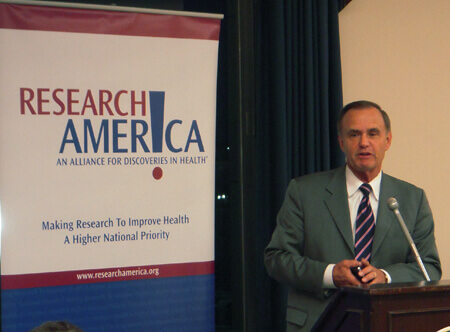Tiffany MoyResearch!America
Tiffany Moy is a global health research and development advocacy Intern at Research!America, a nonprofit that advocates for science, discovery, and innovation to achieve better health for all.
Tiffany Moy is the Global Health Research & Development Advocacy Intern at Research!America (R!A). R!A is the nation's largest not-for-profit public education and advocacy alliance committed to making research to improve health a higher national priority.
R!A, in partnership with Aeras, the International AIDS Vaccine Initiative, the International Partnership for Microbicides and OneWorld Health, hosted a Capitol Hill briefing Nov. 15 on the role of product development partnerships (PDPs) in global health R&D. The event was co-sponsored by Reps. Brian Bilbray (R-CA) and Chris Van Hollen (D-MD).
During the event, Bilbray acknowledged that the health challenges ahead of us will require sustained investment in the R&D process from both the public and private sectors, and he called for bipartisan support for both funding streams.
“We can’t spend time patting ourselves on the backs,” Bilbray said. “[While we can’t] forget to celebrate our successes, we must continue to look at the challenges.”
He declared the public and private collaborative network essential, saying without the basic research—or what he called the “sea plankton”—there would be no venture capital or opportunity to invest in the “krill.”

“We must create the opportunity for people to invest their funds,” he said, “not just for the next iPhone for but the next breakthrough cancer treatment. Otherwise we just have good intentions without good solutions.”
Mary Woolley, president and CEO of Research!America, moderated the discussion between panelists Ann Ginsberg, MD, PhD, vice president of Scientific Affairs at Aeras; Brid Devlin, PhD, executive vice president of Product Development at the International Partnership for Microbicides (IPM); Eugenio de Hostos, PhD, MBA, director of Research and Pre-Clinical Development at OneWorld Health; and Steve Fling, PhD, site director of the International AIDS Vaccine Initiative (IAVI) Neutralizing Antibodies Center at The Scripps Research Institute.
Woolley’s opening remarks emphasized the role of health research as a major driver of the American economy and a key factor in our country’s global leadership.
The panelists discussed how the non-profit PDP model speeds medical progress on diseases like HIV and AIDS, tuberculosis (TB), malaria and diarrheal diseases. PDPs play a vital role in accelerating the research and development of critical health technologies like vaccines, drugs, and diagnostics. The model allows risk sharing but also the sharing of technical resources and scientific expertise.
Fling expressed pride in IAVI’s breakthroughs in the field of HIV and AIDS, as well as in its partnership with Seattle-based biotech Theraclone, which has led to additional partnerships with Pfizer and other drug companies.
Devlin noted that IPM’s microbicide ring, designed to give women greater control over protecting themselves from HIV, is the first such product to come so far in the R&D pipeline. “HIV is the leading cause of death for women ages 15 to 44 worldwide,” she noted. The ring will enter late-stage clinical trials in early 2012.
OneWorld’s de Hostos added that “this is not just about bringing technologies to bear on these diseases but it’s also about capturing the intellectual capital we have here.”
Of solving one of the world’s greatest health challenges through the PDP model, Ginsberg said, “Using business practices, we are combining the public health need and expertise wherever we can find it. Ten years ago, there were no candidates and now there are 12 TB vaccine candidates in the R&D pipeline. [This is] the first time in history that so many TB vaccines have gotten so far” in the development process.
A new, more effective TB vaccine could reach the market as early as 2020 and has the potential to greatly reduce the 1.4 million lives lost to TB each year.
“This,” Ginsberg said, “could not have happened without the PDP model.”
To learn more about how global health R&D is impacting the health and economies of other states, click here.